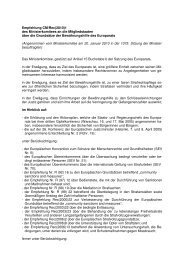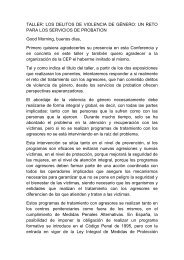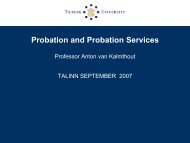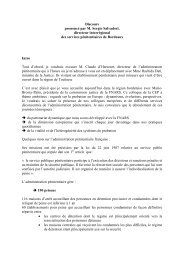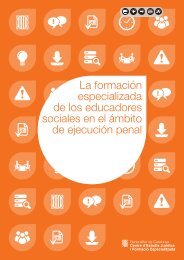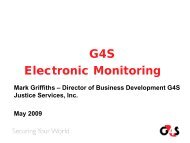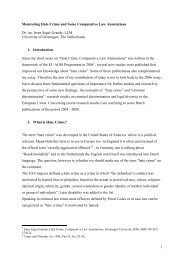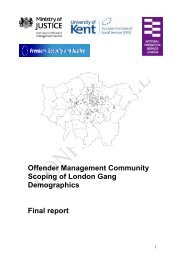Report EM 2005 - E - CEP, the European Organisation for Probation
Report EM 2005 - E - CEP, the European Organisation for Probation
Report EM 2005 - E - CEP, the European Organisation for Probation
Create successful ePaper yourself
Turn your PDF publications into a flip-book with our unique Google optimized e-Paper software.
More generally, <strong>the</strong>re was a question about who should have access to <strong>the</strong> data. In some<br />
cases, <strong>the</strong> police would be justified in seeing it.<br />
As to how long location data should be kept, it was noted that <strong>the</strong> research benefits<br />
would be maximised if data were kept <strong>for</strong> a number of years.<br />
5. THE WORKSHOPS<br />
The conference offered a choice of six workshops, as shown below. The first four were<br />
conducted in English, <strong>the</strong> last two in French.<br />
1. Electronic monitoring of juveniles<br />
2. Offender perspectives on electronic monitoring<br />
3. Electronic monitoring in an immigration context<br />
4. Ethical issues and quality standards<br />
5. Analysing net-widening in <strong>the</strong> context of electronic monitoring<br />
6. Electronic monitoring and social supervision.<br />
The programme included two workshop sessions, each of 90 minutes. A plenary session<br />
<strong>the</strong> following day allowed workshop leaders to summarise <strong>the</strong> discussions in <strong>the</strong>ir<br />
workshop <strong>for</strong> <strong>the</strong> conference as a whole.<br />
5.1 Electronic monitoring of juveniles<br />
Mary Wyman<br />
Mary Wyman told participants about <strong>the</strong> Intensive Supervision and Surveillance<br />
Programme <strong>for</strong> juvenile offenders, and <strong>the</strong> use of tracking technology with juveniles in<br />
Hampshire and <strong>the</strong> Isle of Wight. Research by Ox<strong>for</strong>d University showed that <strong>the</strong><br />
electronic monitoring of juveniles worked better with a human element (<strong>for</strong> example<br />
supervision) than it did on its own.<br />
Participants discussed <strong>the</strong> length of curfews <strong>for</strong> juveniles. The maximum in England and<br />
Wales was three months, and this was considered to be possibly too short. In <strong>the</strong><br />
context of longer curfews, participants were attracted to <strong>the</strong> practice in Holland of<br />
starting with very intensive curfews and gradually allowing more free time as a reward<br />
<strong>for</strong> compliance.<br />
Participants were interested in <strong>the</strong> caseloads, <strong>the</strong> unit costs of electronic monitoring, and<br />
<strong>the</strong> ethics of monitoring young people. It was recognised that politicians needed to be<br />
seen to be doing something about juvenile crime.<br />
There were no real areas of disagreement in <strong>the</strong> workshop, but <strong>the</strong>re was some<br />
discussion about <strong>the</strong> reliability of monitoring equipment, and about whe<strong>the</strong>r staff in<br />
Youth Offending Teams would get on with electronic monitoring staff.<br />
13


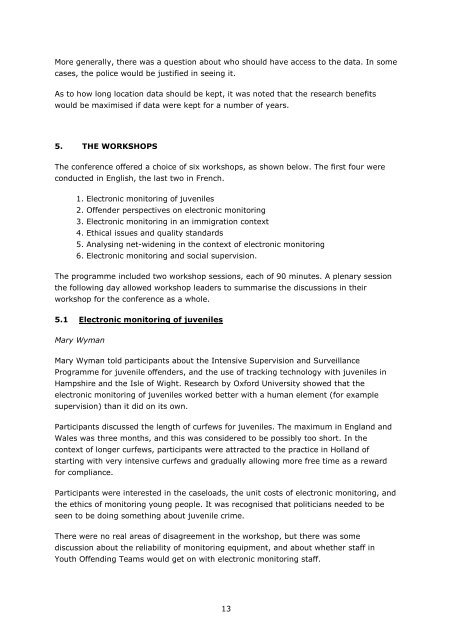

![AGIS2 Nov 08 Conference Report_[Version 2] - CEP, the European ...](https://img.yumpu.com/50764570/1/190x245/agis2-nov-08-conference-report-version-2-cep-the-european-.jpg?quality=85)
